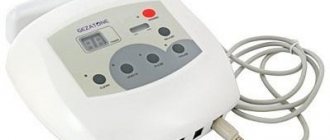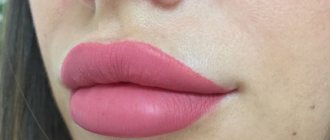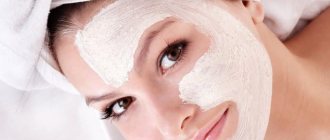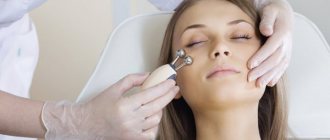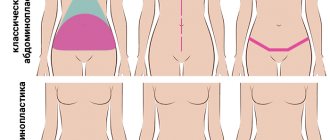Any exfoliation activates the natural regeneration process, promotes the production of collagen fibers, normalizes blood circulation and fills dermal cells with necessary oxygen.
But do not forget that after cleansing the face is exposed to the negative effects of external factors, so it is important to follow the recommendations for caring for the epidermis during the recovery period. Ignoring advice on skin regeneration can lead to side effects and deterioration of the original condition of the dermis.
Possible consequences after facial cleansing and their causes
Cosmetologists warn their patients that after the procedure they may encounter some undesirable consequences. At its core, cleansing refers to a series of aggressive, even traumatic procedures. During the first 24 hours after it, the woman is likely to observe a reaction in the form of redness and slight swelling. This is considered a normal variant and does not require specific therapy.
Unpleasant consequences include the following:
- The formation of inflammatory elements or pimples. If sterility is maintained, this should not happen. The appearance of acne may indicate that the procedure caused the formation of a wound that became infected.
- Redness of the skin. Persistent redness that occurs after cleansing the face, which does not go away for more than 3 days, should alert you. Mechanical impact on the epidermis provokes a rush of blood and redness, which usually goes away after a few days.
- Formation of hematomas. This side effect indicates excess pressure when exposed to the problem area of the dermis.
- Edema. Swelling immediately after mechanical impact is considered normal. However, if after cleansing your face swelling appears and does not go away after three days, this is a reason to seek help from a specialist.
- Wounds and scars can occur if you have sensitive skin or unprofessional cleaning.
- Allergies occur when there is a hypersensitivity reaction to drugs used in cleaning.
How quickly does the redness go away?
During the process of mechanical facial cleansing, an intense effect on the epidermis occurs. As a result, peripheral blood circulation increases and redness occurs on the surface of the dermis. Its intensity and duration depend on the individual characteristics of the patient’s body.
A natural question that arises in the mind of every woman who sees her face after mechanical skin cleansing: how many days does the redness go away? Normally, hyperemia of the epidermis should last no more than three days. If after this period the redness does not go away, then you should definitely consult a doctor. He will select individual therapy. Often, when redness occurs, it is recommended to use ointment with dexpanthenol, as well as make compresses with chamomile or aloe Vera juice.
Which rashes after brushing are considered normal and which are not?
Experienced cosmetologists say: the formation of small superficial pimples after mechanical cleansing is natural and does not pose any danger. Thus, the epidermis gets rid of accumulated impurities and toxins. After vacuum or chemical cleaning, a layer of keratinized scales is removed from the epidermis and inflammation becomes more noticeable, pimples form faster.
In some cases, rashes on the face after cleansing are dangerous:
- the appearance of brightly colored red areas on the skin, similar to a rash, can be the result of a chemical burn;
- small pustules and itching of the skin are a sign of an allergic reaction to products used to treat the face or instrument, or to sunscreen;
- subcutaneous acne can be caused by the use of an excessively greasy product during mechanical cleansing, which is not suitable for the patient’s skin type.
Attention! Squeezing pimples and blackheads is strictly not recommended. There is a high risk of serious complications.
If the above warning signs are detected, you should stop self-medicating and consult a qualified dermatologist.
Proper care after the procedure
The success of facial cleansing largely depends on how a woman follows skin care recommendations. Often cosmetologists supplement Metrogyl cleansing with gel and this gives a good effect. However, the use of antibiotics is not always justified or appropriate. Then cosmetologists advise the following actions:
- Wash your face with melt water or mineral water. You can also add lemon juice and apple cider vinegar to the solution. In this way, the surface of the epidermis is acidified and many problems with inflammation are solved.
- During the rehabilitation period, pamper your skin with fortified cocktail compositions for facial skin.
During the process of cleansing the face and in the subsequent rehabilitation period, compliance with these rules will minimize or avoid the formation of inflammatory elements:
- meticulously maintain cleanliness of skin, hands and tools;
- choose your favorite skin care products that suit your skin type;
- do not abuse cosmetic products with comedogenic effects;
- reduce your time in the sun;
- adjust your diet by eliminating junk food and enriching it with vegetables and fruits.
Summary
You already know what you should not do after cleansing your face and how to care for your skin after manipulation, depending on the type of procedure. If everything is done correctly, the recovery period will be short, without visible side effects or complications.
Experts recommend performing cosmetic procedures exclusively in specialized institutions. If mechanical and partially vacuum cleaning are relatively simple manipulations that do not require special knowledge, then other hardware procedures are very specific.
Today, the beauty industry market offers a lot of portable devices for home use. If you still decide to do the procedure yourself, consult a specialist before doing so. He will be able to conduct diagnostics, determine the range of contraindications, and give practical advice both on the procedure itself and on care after it.
Once again we draw your attention! The effect of cleaning depends on the professionalism of the cosmetologist, adherence to post-care rules, good mood and the desire to improve your appearance.
What is not recommended?
At the moment when the face begins to heal after cleansing, a woman should limit herself to a number of procedures. This is a list of actions that absolutely cannot be performed after cleaning:
- for 2-3 days, minimize exposure to the street, do not wash your face, and avoid any exposure to the skin;
- for a week refuse to visit the bathhouse, sauna, swimming pool;
- do not wash your face with hot water or chlorinated tap water;
- do not drink alcoholic beverages;
- do not exfoliate the skin using scrubs;
- do not injure the skin mechanically;
- do not use creams with natural ingredients to avoid an allergic reaction;
- do not wash your face with soap, which dries out the epidermis and leads to the formation of cracks;
- Do not overload your skin with cosmetic products.
Summarize
A visit to a cosmetologist should be planned in advance, since after most procedures the skin requires 3 to 7 days to recover. Proper care after peeling or cleaning will allow you to get the best possible effect. And if there are contraindications and a visit to a specialist is not possible, use high-quality home facial care products.
Popular questions on the topic:
✅ What can't be done after cleansing your face?
Facial cleansing is a fairly aggressive method of exposure to the skin, so proper restoration is necessary. Within 5-7 days after the procedure you cannot:
- apply makeup immediately after the procedure;
- constantly touch the skin of the face;
- use alcohol-containing lotions;
- use scrubs and exfoliate;
- visit the bathhouse, sauna.
The recovery time after ultrasonic facial cleansing is minimal, so if you need to quickly get your face in order, choose this method.
✅ Is it possible to put on makeup after cleansing your face?
Any facial cleansing involves some trauma to the skin, so it is important to give it time to recover. The rehabilitation period depends on the chosen cleaning method. But in any case, for the first 24 hours after any procedure.
✅ What to do after cleansing your face?
The skin needs time to recover after cleaning by a cosmetologist so that no side effects occur. To do this, you need to properly care for your face:
- the first 24 hours after the procedure there is no aggressive effect on the skin, we try not to even touch the face;
- In no case do we use alcohol-containing products for at least 1-3 days;
- During the week, we wash ourselves with herbal decoctions instead of ordinary water;
- apply moisturizer to the face 1-2 times a day;
- Make nourishing and soothing face masks several times a week.
Subscribe to our Yandex.Zen channel or Yandex.Messenger
What is possible?
In order to minimize the negative consequences of mechanical facial cleansing, you can use gentle cosmetic procedures:
- Darsonval - electrical stimulation of the epidermis, improving regenerative processes. It is completely safe, does not cause discomfort and effectively helps eliminate redness, swelling and inflammation.
- Cryomassage is the effect of liquid nitrogen on the epidermis. The effect is noticeable after the first procedure: the skin calms down, the discomfort goes away.
- The use of homemade masks based on herbs: chamomile, plantain, celandine and calendula. Good ingredients include cucumbers, clay, egg, lemon, bodyaga, coffee grounds, kefir, and yeast.
Tips to avoid side effects
Before answering the question of how many days redness lasts after mechanical facial cleansing, the cosmetologist gives a number of recommendations to the patient. The negative consequences of the procedure can be easily avoided if:
- carry out the procedure in a cosmetologist’s office, which is equipped with special equipment and materials to ensure sterility;
- trust only a qualified technician;
- strictly follow all recommendations of a doctor or cosmetologist for skin care during the rehabilitation period.
All these tips will help you avoid facial redness after cleansing. The result of the procedure will be only radiant clean skin.
For a variety of facial skin cleansing methods, watch the video:
Rules for using masks
So, after cleansing, any type of face is recommended by experts and even requires special masks. In order for the presented compositions to be effective to the maximum extent, it is necessary to adhere to certain rules and try not to conduct unnecessary experiments on the skin. The rules are:
- It is recommended for some time after cleansing to use the mask recommended by the cosmetologist who performed it;
- when the consequences of cleansing turn out to be very serious, you should not try all the remedies in a row: you need to make masks containing antiseptics and medications;
- if the consequences of cleansing are completely normal, then facial compositions made from fruits or vegetables are perfect;
- any mask should be pre-tested and applied to the skin in a thin layer;
- You should not get carried away with masks: it is recommended to do them once every 3-4 days.
For whom is facial cleansing contraindicated?
Mechanical cleansing is one of the simplest methods of affecting the skin and does not require specific equipment. However, there are a number of contraindications to this procedure:
- skin diseases in the acute stage;
- increased sensitivity and dryness of the epidermis;
- menstruation;
- circulatory diseases;
- asthma;
- arterial hypertension;
- the presence of papillomas, moles;
- rosacea;
- tendency to develop acne.
If at least one of these signs is present, it is better to refuse mechanical cleansing of the face.
Types of skin cleansing procedures
There are many ways to cleanse your face, so we will focus only on the most popular ones. The first is mechanical cleaning. The method is quite outdated, but effective. Its essence lies in the fact that a cosmetologist, using special products or simple hot water, steams the skin of the face, and then with his hands and special devices removes all pimples, blackheads and pores clogged with dust and cosmetic residues.
The disadvantage of the procedure is possible pain and inflammation of the skin, which can last for several days. A more modern analogue of such cleaning is an ultrasonic procedure. In this case, a gel is applied to the skin of the face, and then the cosmetologist performs manipulations using a special apparatus. Ultrasonic waves cleanse clogged pores, and the finishing mask tightens them. This procedure is completely painless, but sometimes requires additional mechanical influences.
Vacuum cleaning is also a salon procedure. The cosmetologist seems to pull out all the impurities using a special tube. In addition to the cleansing effect, the procedure also has a lifting effect. This cleansing improves blood flow, and if done regularly, increases skin elasticity. However, it is not suitable for overly contaminated and problematic skin.
There is also dry cleaning. In this case, a special composition is applied to the skin that can expand the pores and draw out all the impurities from them. The unpopularity of such cleansing is due to the fact that any inflammation and acne can become an obstacle to this procedure.

